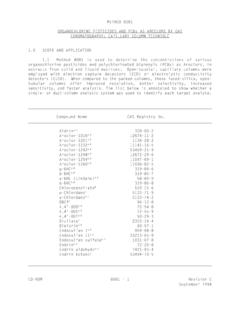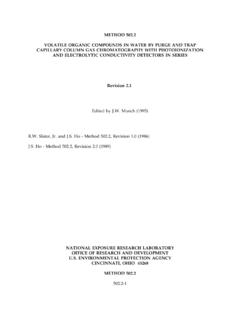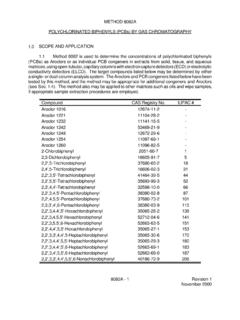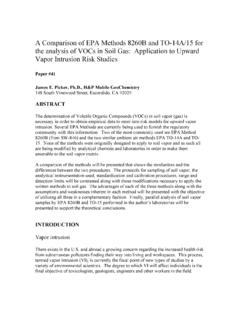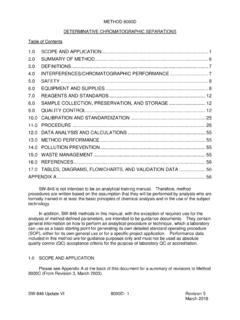Transcription of Analysis of benzene, toluene, ethylbenzene and …
1 Journal of Chromatography B, 778 (2002) 199 / locate / chrombAnalysis of benzene , toluene , ethylbenzene andm-xylene inbiological samples from the general populationLuigi Perbellini, Francesco Pasini, Serena Romani, Andrea Princivalle,*Francesco BrugnoneChair of Occupational Medicine,Department of Medicine and Public Health University of Verona,Policlinico ,ItalyAbstractA method for the determination of benzene , toluene , ethylbenzene and xylene in blood and urine of people notoccupationally exposed to solvents is described. The headspace technique combined with gas chromatography with a massspectrometer detector is used. The sensitivity of recent mass spectrometers is good enough to furnish reliable results also inbiological samples collected from the general population. No treatment for concentrating solvents present in the blood orurine is necessary.
2 The main features of the method are easy preparation of biological samples, small volumes (7 ml), goodrepeatability and linearity in the range of interest. The limits of detection in blood were 16, 43, 22 and 52 ng / l for benzene , toluene , ethylbenzene andm-xylene respectively. Slightly greater sensitivity was found for urine samples. The resultsobtained in biological samples from 25 woodworkers not occupationally exposed to BTEX (15 non-smokers and 10smokers) are comparable to those obtained by other investigators. 2002 Elsevier Science All rights : benzene ; toluene ; ethylbenzene ;m-Xylene1. IntroductionMeasurement of these solvents in blood and urinesamples collected from the general population can beBenzene, toluene , ethylbenzene andm-xyleneused to calculate the individual body burden and to(BTEX) are ubiquitous pollutants mainly due toestablish the reference values for comparing data forengine emissions, tobacco smoke and industrialoccupational They have been measured in indoor andThe quantification of BTEX in biological samplesoutdoor air samples by several groups of researchersis not an easy task when their concentrations are[1 5].
3 Lower than 1mg / l as usually happens in people notThese aromatic hydrocarbons are also detectableoccupationally exposed to biological samples: Wallace et al. [3] have re-In a recent article, Fustinoni et al. [6] describe aported concentrations ranging from 1 and 12 ng / l inreliable method for measuring BTEX in urine basedalveolar air of people not occupationally exposed toon headspace solid-phase microextraction at features of the method are: Linearity in therange of interest (from the detection limits up to5000 ng / l), good repeatability (coefficient of vari-*Corresponding (F. Brugnone).ation 2 7%), high specificity related to mass spec-1570-0232 / 02 / $ see front matter 2002 Elsevier Science All rights : S0378-4347(01) et (2002) 199 210trometric detection and detection limit in the 12 34solutions obtained had concentrations of 200, 20 andng / l / l, respectively, and were used to spike thePreviously, Kok and Ong [7] and Kivisto et al.
4 [8]calibration samples: For example, the preparation ofsuggested measuring benzene in blood and urinea urine or blood sample containing 240 ng / l of eachusing a method based on headspace gas chromatog-hydrocarbon was done by adding 84ml of the 20raphy and photoionisation detection. The biologicalmg / l solution to a vial containing 7 ml of a bio-samples are incubated at 608C for 30 min and mllogical headspace gas is used for the GC Analysis . TheThe internal standard solution containing deuter-recovery and reproducibility are over 90%. Theated benzene in water (50mg / l) was prepared dailydetection limits of benzene in blood and urine are 54by diluting a methanol solution of 100 mg / l in waterand 43 ng / l, respectively [7]. Similar results were(1:2000).obtained by Kivisto et al. [8], apart from theA volume of 30ml of the solution obtained wasdetection limits which were higher than those re-added to 7 ml of biological by the previous research group (about 350 All adding operations (both standards and internalng / l for both blood and urine).)
5 Standard) were performed with a microsyringe whosePerbellini et al. [9] and Ghittori et al. [10] haveneedle perforated the septa of the closed vials. Thispublished results for solvents in biological mediatechnique is less pollutant than the one in which thefrom the general population using differently appliedvials are opened in order to add standards and purge and trap techniques. The detection limits forinternal with these methods range from 15 to 50 article describes the simultaneous of benzene , toluene , ethylbenzene andm-Glass tubes ( ml effective volume) with PTFE xylene in blood and urine. The sensitivity of recentsepta and screw caps were used for storage ofmass spectrometers yields reliable results also inbiological samples immediately after collection. Allbiological samples from the general pieces of equipment were maintained at 808 Cfor almost 24 h; before use, glass tubes wereadditionally cleaned by fluxing with ultra-pure same treatment was used for glass vials (11 mlvolume), and their PTFE septa and aluminium seals2.
6 Experimentalwhere the biological samples were transferred foranalysis. Immediately after introducing the samples, vials were closed with 20 mm butyl rubber linedwith PTFE septa and crimped with perforated and standard preparationminium , toluene , ethylbenzene ,m-xylene andThe biological samples were injected into themethanol (laboratory grade purity) were purchasedgas-chromatograph with an HP 7694E headspacefrom Carlo Erba (Milan, Italy). benzene -d (. (Hewlett-Packard), connected via a6atom % D) was obtained from Sigma Aldrichvolatile interface configured in the direct injection(Milan Italy). methanol solution containing the 4 aromaticAn HP 6890 gas chromatograph (Hewlett-Pac-hydrocarbons was prepared: Each product was pres-kard), interfaced with the HP 5973 mass detectorent at a concentration of 200 mg / l (about 23ml ofoperating in the electron impact (EI) mode was solvent in 100 ml of methanol).
7 This solutionThe gas chromatograph was equipped with awas maintained at column: PoraPLOT Q (5 m length, mmThe preparation of daily calibration curves , 10mm film thickness, Chrompack) connected towith the solution described which was diluted 1000,an HP-5MS (30 m length, mm , 000 and 100 000 times in water. The waterfilm thickness, Hewlett-Packard). et (2002) 199 collectionaromatic hydrocarbon was calculated according toTo study the features of the method, blood andthe expression: LOD5(3Sy2a)/bwhereSyis theurine samples were obtained from a non-smokingstandard error of the estimate, a is the intercept andvolunteer. The urine specimens were collected di- b the from the donor in 500 ml glass bottles. ThreeThe repeatability of the assay (as coefficient ofhundred and fifty ml of blood were supplied by twovariation, ) was estimated by repeated analysishealthy researchers from our laboratory.
8 The samplesof urine and blood samples (5 per concentration)were stored at 48C until Analysis (2 3 days).spiked with BTEX at the concentrations of 60 andAnother 25 urine and blood samples were obtained480 ng / l for urine and spiked with 60 and 480 ng / lfrom a group of 25 woodworkers living in rural( benzene and toluene ) or 120 and 960 ng / l (ethyl-areas. Ten of them smoked 3 20 cigarettes a day, benzene andm-xylene) for blood. Accuracy waswhile the other 15 were non-smokers. Biologicalcalculated after subtracting the background concen-samples, immediately after collection, were placed intration of the biological samples and comparing theglass tubes which were filled to capacity, closed withresults with the spiked amounts: The mean per-screw caps and maintained at 48C until test time (nocentage ratio was than 4 days). Blood samples were added with 2drops of EDTA as an chromatography mass spectrometryA headspace auto-sampler using a loop volume preparation1 ml was used.
9 After a 60 min equilibration over aThe urine and blood samples (7 ml) were trans-rotating shaker at room temperature (22 238C),ferred after gentle mixing, into the open Analysis vialurine samples were placed on the washed with ultra-pure air. Thirty microlitres ofBlood samples were heated at 508C and shaken forinternal standard solution were added to the final60 min in the autosampler before the headspace wasconcentration of 200 ng / l. These operations werewithdrawn: The loop and transfer line temperaturesperformed both 1108C. The transfer line was connected tothe gas-chromatograph via a volatile interface control(Calibration,detection limitat 1208C with a split removed repeatability)The oven temperature of the gas-chromatographUrine and blood from non-smoking, non-oc-was kept at 1008C during the injection (1 min). Thecupationally-exposed donors were used for calibra-temperature was then increased to 2108C at a rate oftion and estimation of the repeatability of the / min and this temperature was maintained for 4 For calibration, the samples were prepared asmin.
10 Helium was used as the carrier at ml / urine calibration samples spiked with 0, 15,The mass detector, with the source kept at 2508C,30, 60, 120, 240, 480 and 960 ng / l of BTEX, andoperated in electron impact mode with the selectedeight blood calibration samples spiked with 0, 15,ion monitoring mode. The solvent delay time was 330, 60, 120, 240, 480 and 960 ng / l of benzene andmin, and the dwell time 50 ms. The masses detectedtoluene and 0, 30, 60, 120, 240, 480, 960 and 1920werem/z78 and 77 for benzene , 91 and 97 forng / l of ethylbenzene andm-xylene were , 91 and 106 for ethylbenzene and samples were run as described inBenzene-d as internal standard was monitored with6 Section The 2 masses recorded for each compoundLeast-squares linear regression Analysis was usedwere used to check the isotopic ratio; their quantifi-to estimate the slopes (b) and intercepts (a) of thecation was based on the peak areas of the followingcalibration curvesy5bx1a, whereyis the chro-masses: 78 for benzene , 84 for benzene -d and 91 for6matographic area of the analyte andxis the samplethe other of the analyte (ng / l).

